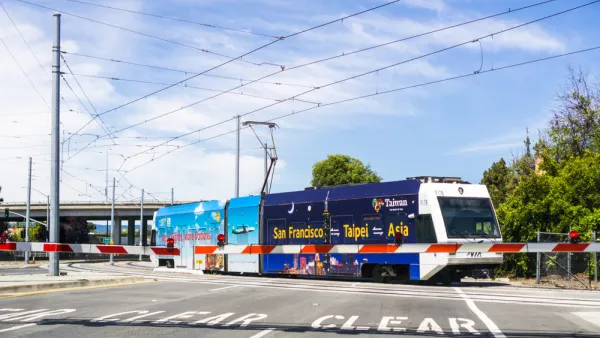Randal O'Toole claims that light rail transit is more dangerous than bus or automobile travel, but he fails to account for exposure or overall safety benefits. This is a good example of bad statistical analysis.
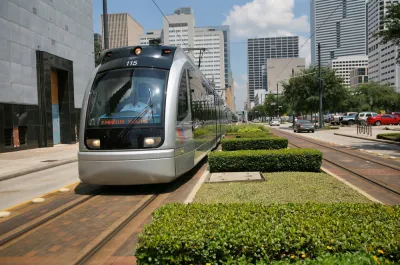
Randal O'Toole, who labels himself the "anti-planner" recently posted a blog, Light Rail Increasingly Dangerous, in which he estimates that light rail transit (LRT) causes 12.5 traffic fatalities per billion passenger-miles, compared with 4.9 for automobiles and just 4.5 for buses. He concludes that light rail is 2.5 times more dangerous than automobile travel. This is a good example of bad analysis.
O'Toole makes two major errors: he fails to account for exposure (the amount and type of risks that travelers experience), and ignores the various ways that high quality public transit tends to increase safety overall. People unfamiliar with the nuances of traffic risk analysis may find his evidence persuasive, but experts will recognize its errors. This explains why critics like O'Toole so seldom publish in peer-reviewed journals; their analysis cannot withstand professional scrutiny.
Most light rail accident victims are pedestrians. Light rail transit only operates in dense city centers where there are frequent interactions between various road users. Would buses and automobiles have lower crash rates under these conditions? They might. Trains cannot steer around an obstacle and are quieter than buses or cars, which might increase risks, but LRT also has features, such as professional drivers and wheel covers, that reduce risks. O'Toole's statistics do not really prove that light rail is more dangerous than other modes operating under the same conditions, we need an apples-to-apples comparison to answer that question.
My research indicates that public transit investments can provide large community-wide safety benefits. Public transit travel has about a tenth the per passenger-mile traffic fatality rate as automobile travel, and total (pedestrian, cyclist, transit passenger, and automobile occupant) per capita traffic fatality rates tend to decline as transit ridership increases in a community. Many of these benefits are only perceivable if traffic risk is measured per capita rather than using distance-based indicators, such as fatalities per billion passenger-miles, since the benefits result, in part, from reductions in per capita vehicle travel. As a result, comparing crash risk per billion passenger-miles cannot reflect the full safety benefits of high quality public transit or transit-oriented development.
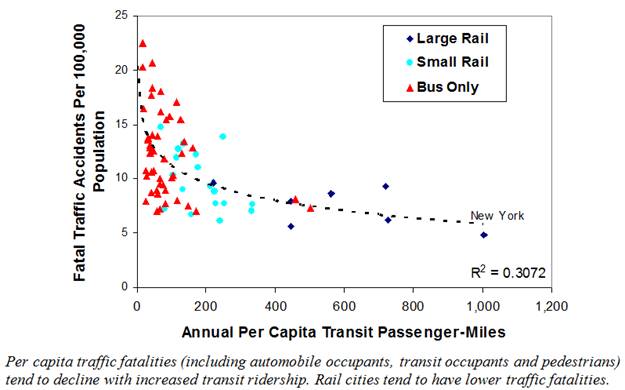
My recent journal article, A New Transit Safety Narrative, summarizes new research regarding public transit safety and security impacts. It found that cities with more than 50 annual transit trips per capita have about half the average traffic fatality rate as regions with less than 20 annual trips per capita, and residents of transit oriented developments have about a fifth the traffic fatality rates (that is, traffic fatalities decline 80 percent) as in automobile-dependent neighborhoods, indicating that relatively modest increases in transit travel are associated with large traffic safety gains, as illustrated below.
Traffic Fatalities Versus Transit Trips
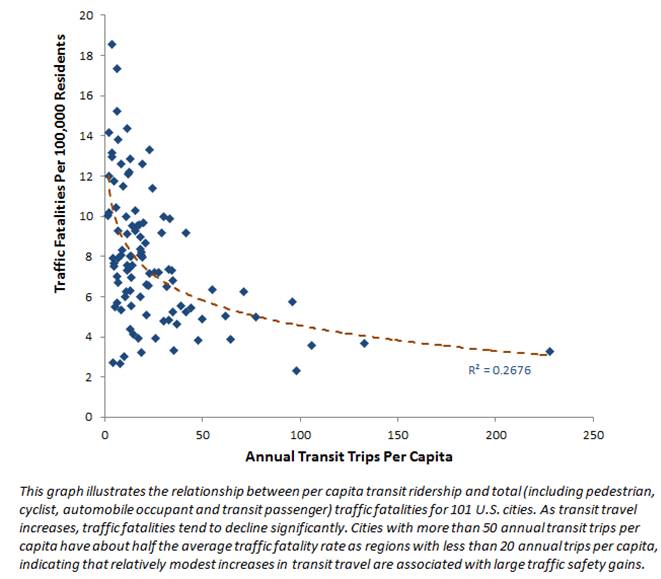
Several factors probably contribute to these crash reductions. Transit-oriented community residents tend to drive less, local traffic speeds are lower, and higher-risk groups, such as driving by youths, seniors and drinkers, have good travel options which allows them to reduce their driving. As a result, traffic safety policies intended to reduce high-risk driving, such as graduated licenses and anti-drunk-driving campaigns, are likely to be more effective if implemented with public transit service improvements and more transit-oriented development.
As evidence, consider the following graph, which shows that the reduction in traffic deaths in more transit-oriented cities is particularly strong for youths, which suggests that many young people want to reduce their vehicle travel and associated traffic risk but can only do so if they have good alternatives. High quality transit and transit-oriented development help make this happen.
Youth and Total Traffic Fatality Rates
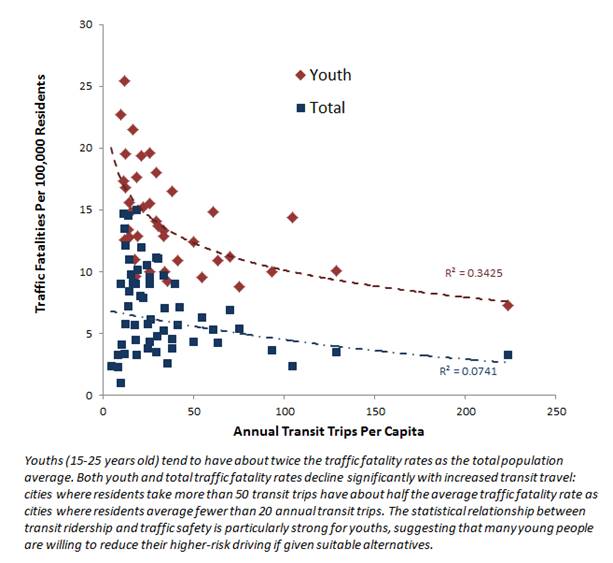
O'Toole's analysis ignores these impacts and so undervalues public transit safety benefits. Most cities with high transit ridership have rail transit serving their downtown core. It is possible that high quality bus services, such as bus rapid transit, could provide the same benefits, but there are also good arguments for light rail transit on dense urban travel corridors: rail is quieter and more comfortable, can carry more passengers, attract more discretionary passengers (people who would otherwise drive), and tends to be more effective at stimulating transit-oriented development. Although LRT is not appropriate everywhere, it plays an important role in creating transit-oriented cities, thereby achieving substantial safety and cost savings benefits.
This is just one example of the importance of using an accurate framework for intermodal comparisons. I’ve seen other examples of bad analysis. For example, when comparing travel speeds, fuel consumption or operating costs between different modes it is important to use values that represent actual travel conditions rather than averages. Most light rail transit (LRT) travel occurs in congested urban conditions where vehicle speeds are relatively low and operating costs relatively high, so LRT costs should be compared with automobiles operating under urban-peak conditions. Similarly, rail transit line costs are sometimes compared with the average costs of building a roadway lane, without taking into account the relatively costs of building infrastructure in central cities. Accurate analysis accounts for these differences.
For More Information
Joshua Broyles (2014), Drinking and Driving and Public Transportation: A Test of the Routine Activity Framework, Master’s Degree Thesis, Arizona State University.
Todd Litman (2015), "Impacts of Rail Transit on the Performance of a Transportation System," Transportation Research Record 1930, Transportation Research Board, pp. 23-29; full report at www.vtpi.org/railben.pdf.
Todd Litman (2009), “Transportation Policy and Injury Control,”Injury Prevention, Vol. 15, Issue 6.
Todd Litman (2014), “A New Transit Safety Narrative,” Journal of Public Transportation, Vol. 17, No. 4, pp. 114-135; at; also see at www.vtpi.org/safer.pdf
Todd Litman and Steven Fitzroy (2005), Safe Travels: Evaluating Mobility Management Traffic Safety Impacts, Victoria Transport Policy Institute.
Ian Savage (2013). “Comparing The Fatality Risks In The United States Transportation Across Modes And Over Time,”Research in Transportation Economics, Vol. 43, No. 1, pp. 9-22.
Uber and MADD (2015), More Options. Shifting Mindsets. Driving Better Choices., Uber and Mothers Against Drunk Driving.

Analysis: Cybertruck Fatality Rate Far Exceeds That of Ford Pinto
The Tesla Cybertruck was recalled seven times last year.

National Parks Layoffs Will Cause Communities to Lose Billions
Thousands of essential park workers were laid off this week, just before the busy spring break season.

Retro-silient?: America’s First “Eco-burb,” The Woodlands Turns 50
A master-planned community north of Houston offers lessons on green infrastructure and resilient design, but falls short of its founder’s lofty affordability and walkability goals.

Test News Post 1
This is a summary

Analysis: Cybertruck Fatality Rate Far Exceeds That of Ford Pinto
The Tesla Cybertruck was recalled seven times last year.

Test News Headline 46
Test for the image on the front page.
Urban Design for Planners 1: Software Tools
This six-course series explores essential urban design concepts using open source software and equips planners with the tools they need to participate fully in the urban design process.
Planning for Universal Design
Learn the tools for implementing Universal Design in planning regulations.
EMC Planning Group, Inc.
Planetizen
Planetizen
Mpact (formerly Rail~Volution)
Great Falls Development Authority, Inc.
HUDs Office of Policy Development and Research
NYU Wagner Graduate School of Public Service




























